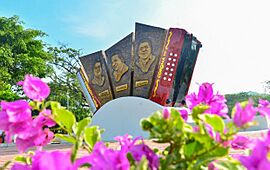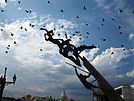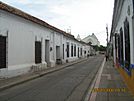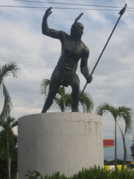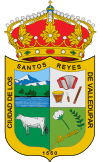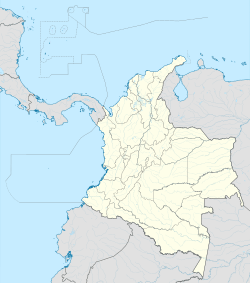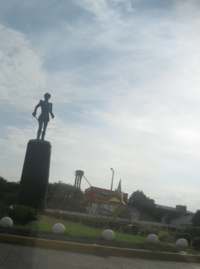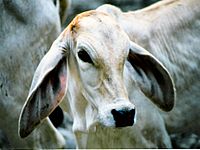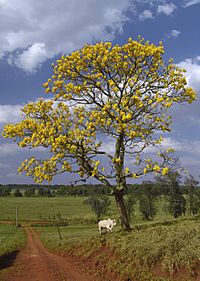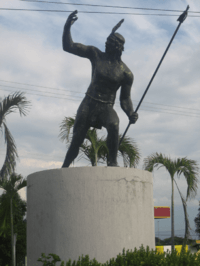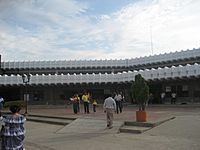Valledupar facts for kids
Quick facts for kids
Valledupar
|
|||
|---|---|---|---|
|
Municipality and city
|
|||
|
From above and from left to right: Aerial panoramic view, Monument to the Revolution in March, Calle 15 in the Historic Center, Statue of Cacique Upar and the Guatapuri River
|
|||
|
|||
| Nickname(s):
Ciudad de los Santos Reyes de Valledupar (City of the Holy Kings of Valledupar)
|
|||

Location in the Department of Cesar. Municipality (dark gray), City (red).
|
|||
| Country | Colombia | ||
| Region | Caribbean | ||
| Department | Cesar | ||
| Foundation | January 6, 1550 | ||
| Area | |||
| • Municipality and city | 4,977.66 km2 (1,921.89 sq mi) | ||
| • Urban | 47.53 km2 (18.35 sq mi) | ||
| Elevation | 168 m (551 ft) | ||
| Population
(2018 census)
|
|||
| • Municipality and city | 490,075 | ||
| • Density | 98.45490/km2 (254.9970/sq mi) | ||
| • Urban | 431,794 | ||
| • Urban density | 9,084.7/km2 (23,529.2/sq mi) | ||
| Demonym(s) | Vallenato | ||
| Time zone | UTC-05 (Eastern Time Zone) | ||
| Postal code |
200001-200005
|
||
| Area code(s) | 57 + 5 | ||
| Climate | Aw | ||
| Website | Official website: http://www.valledupar.gov.co/ | ||
Valledupar is a city in northeastern Colombia. It is the capital of the Cesar Department. Its name means "Valley of Upar," honoring a local Native American leader named Cacique Upar. The city is located between the Sierra Nevada de Santa Marta and Serranía del Perijá mountains, near the Guatapurí and Cesar rivers.
Valledupar is a key center for farming, raising cattle, and coal mining. It's also famous as the birthplace of vallenato music, a very important part of Colombian culture. The city hosts the annual Vallenato Legend Festival. Valledupar also has one of Colombia's most modern maximum security prisons.
Contents
Exploring Valledupar's Geography
Valledupar is located southeast of the Sierra Nevada de Santa Marta mountains. The average temperature is 28 °C. Because of its height and closeness to the equator, it has many different environments. These range from warm areas to places with permanent snow.
Mountains and Rivers of Valledupar
Important mountains in Valledupar include the peaks of Sierra Nevada de Santa Marta: Codazzi, El Guardian, Ojeda, and La Reina. Many rivers flow from these snowy peaks and lagoons. These include the Ariguani, Badillo, Cesar, and Guatapuri rivers. The Guatapuri River flows right next to the city of Valledupar.
Where is Valledupar Located?
The Municipality of Valledupar shares borders with several other areas. To the north, it borders Riohacha and San Juan del Cesar in the La Guajira Department. To the south, it borders El Paso and Los Robles La Paz in the Cesar Department. To the east, it borders Villanueva and Urumita in La Guajira. To the west, it borders Fundacion and Aracataca in the Magdalena Department.
The municipality covers about 4,977.96 square kilometers. A part of this land belongs to Native American reserves. These include 72,660 square kilometers for the Arhuaco Indian Reserve and 399.52 square kilometers for the Kogui and Wiwa Indian Reserve. Also, 425.60 square kilometers are part of the Sierra Nevada de Santa Marta National Park.
Amazing Animals and Plants
Valledupar is home to many unique plants and animals. Most of these live in the Sierra Nevada de Santa Marta and Serrania del Perijá mountains. These areas are known for having a huge variety of life. A new type of bee, called Stelis vallenata, was found here. It was named after the local Vallenato music.
The official bird of the city is the Turpial. You can also see many parrots flying around fruit trees all year.
Long ago, during the colonial period, Europeans brought new animals and plants. They introduced dogs, cats, horses, and cattle. They also brought mango trees, which are now very common. However, the city's special trees are two types of Yellow Tabebuia. Locals call them "Cañaguate" and Puy. These trees fill the area with bright yellow flowers during the dry season.
Groups like the Colombian Ministry of Environment help protect these animals and plants. Local agencies and the Environmental Police also work to keep nature safe.
Understanding Valledupar's Climate
Valledupar's climate depends on how high up a place is. Half of the region has mountains, and the other half is flat land between mountain ranges. Throughout the year, there are two dry seasons and two rainy seasons. These are affected by El Niño and La Niña weather patterns. The mountain peaks get snow during the rainy season. They also have cooler days. Sometimes, the region experiences light hailstorms and thunderstorms. The area is also slightly affected by the yearly Caribbean hurricane season.
During the rainy season, rivers and other water bodies grow larger. Plants become green and full. In the dry season, plants dry out and turn yellow. Water bodies also shrink.
In 2013, Valledupar was named the hottest place in Colombia on average. This was reported by the Colombian Meteorological Institute, IDEAM.
| Climate data for Valledupar, Guaymaral 50 m (1981–2010) | |||||||||||||
|---|---|---|---|---|---|---|---|---|---|---|---|---|---|
| Month | Jan | Feb | Mar | Apr | May | Jun | Jul | Aug | Sep | Oct | Nov | Dec | Year |
| Record high °C (°F) | 39.5 (103.1) |
39.8 (103.6) |
42.0 (107.6) |
39.8 (103.6) |
39.4 (102.9) |
40.8 (105.4) |
46.0 (114.8) |
40.2 (104.4) |
39.0 (102.2) |
38.2 (100.8) |
38.0 (100.4) |
39.8 (103.6) |
46.0 (114.8) |
| Mean daily maximum °C (°F) | 36.4 (97.5) |
36.5 (97.7) |
36.6 (97.9) |
36.5 (97.7) |
35.5 (95.9) |
35.4 (95.7) |
35.7 (96.3) |
35.5 (95.9) |
34.6 (94.3) |
33.8 (92.8) |
34.1 (93.4) |
35.1 (95.2) |
35.3 (95.5) |
| Daily mean °C (°F) | 30.4 (86.7) |
30.5 (86.9) |
30.3 (86.5) |
30.2 (86.4) |
29.7 (85.5) |
29.8 (85.6) |
29.9 (85.8) |
29.8 (85.6) |
29.3 (84.7) |
28.8 (83.8) |
29.0 (84.2) |
29.7 (85.5) |
29.8 (85.6) |
| Mean daily minimum °C (°F) | 23.8 (74.8) |
24.3 (75.7) |
24.3 (75.7) |
24.2 (75.6) |
24.2 (75.6) |
24.2 (75.6) |
24.2 (75.6) |
24.0 (75.2) |
23.7 (74.7) |
23.6 (74.5) |
23.6 (74.5) |
23.5 (74.3) |
23.9 (75.0) |
| Record low °C (°F) | 16.8 (62.2) |
19.8 (67.6) |
20.6 (69.1) |
18.2 (64.8) |
18.0 (64.4) |
20.4 (68.7) |
17.2 (63.0) |
18.0 (64.4) |
17.2 (63.0) |
18.8 (65.8) |
18.4 (65.1) |
17.2 (63.0) |
16.8 (62.2) |
| Average precipitation mm (inches) | 6.8 (0.27) |
28.5 (1.12) |
78.1 (3.07) |
125.9 (4.96) |
181.3 (7.14) |
119.1 (4.69) |
114.4 (4.50) |
140.7 (5.54) |
154.8 (6.09) |
169.7 (6.68) |
148.9 (5.86) |
40.0 (1.57) |
1,295.3 (51.00) |
| Average precipitation days | 1 | 2 | 5 | 9 | 11 | 9 | 9 | 12 | 12 | 12 | 9 | 3 | 94 |
| Average relative humidity (%) | 63 | 62 | 63 | 63 | 66 | 65 | 65 | 66 | 68 | 70 | 69 | 65 | 66 |
| Mean monthly sunshine hours | 269.7 | 234.5 | 238.7 | 201.0 | 189.1 | 186.0 | 207.7 | 210.8 | 180.0 | 179.8 | 201.0 | 244.9 | 2,543.2 |
| Mean daily sunshine hours | 8.7 | 8.3 | 7.7 | 6.7 | 6.1 | 6.2 | 6.7 | 6.8 | 6.0 | 5.8 | 6.7 | 7.9 | 7.0 |
| Source: Instituto de Hidrologia Meteorologia y Estudios Ambientales | |||||||||||||
A Brief History of Valledupar
The Spanish named the area "Valle de Upar" (Valley of Upar). This was in honor of a local Native American leader, cacique Upar, who led the Chimila. A German governor named Ambrosius Ehinger first explored and conquered the area in 1532.
The city was officially founded in 1550 by a Spanish explorer, Captain Hernando de Santana. He named it. The Catholic Church often called it Ciudad de los Santos Reyes de Valle de Upar. This means "city of the holy kings of Valledupar." It was founded on January 6th, the day the three kings visited Jesus. Over time, the name changed to Valle Dupar and then to Valledupar.
Since colonial times, the region has been a hub for trade. Goods from the Caribbean came here and were sent inland. The Spanish introduced farming and raised European cattle. Many of the native Chimila people died from new diseases brought by the Europeans. Survivors were forced to work, and many died in battles.
On May 22, 1810, about 400 people in Valledupar rebelled against Spanish rule. They protested against the mayor. In 1813, María Concepción Loperena de Fernandez de Castro declared independence from Spain. She was a wealthy landowner who helped supply horses to Simón Bolívar's army.
In 1850, Valledupar became the capital of the Valledupar Province. In 1864, it became the capital of the Valledupar Department. In 1915, Valledupar was made a municipality. The region remained somewhat isolated from the rest of Colombia. This was because it was not considered very important at the time.
During World War II, many people from Europe came to the city. These included French, Germans, and Italians. Later, immigrants from the Middle East also arrived. In 1956, the Catholic Church made it a parish. When the Cesar Department was created in 1967, Valledupar became its capital.
The region began to grow quickly. This was thanks to support from former President Alfonso López Michelsen. Valledupar became known as "Caribbean surprise" (sorpresa caribe). This was due to its fast economic growth in the 1970s. Cotton production, called "white gold" by locals, was a big part of this growth. Valledupar became one of Colombia's most profitable regions. The city's culture also grew strong during these years. The revival of Vallenato music became a symbol of Colombian culture.
A period of violence began in the mid-1980s. This slowed down the peaceful growth. Despite this, Valledupar continued to develop as an important center for farming and cattle raising. It is most famous as the home of vallenato music. This music is played with an accordion, a small drum (caja), and a scraping instrument (guacharaca). Since 1968, the city has hosted the annual four-day Vallenato Legend Festival at the end of April.
People and Learning in Valledupar
Education in Valledupar
Education in Colombia is managed by the Ministry of National Education. This ministry also approves private and public schools.
The largest middle and high school in Valledupar is the Colegio Nacional Loperena. Some of the top high schools are Fundación Colegio Bilingüe de Valledupar, Colegio La Sagrada Familia, Colegio Gimnasio del Norte, Colegio San Fernando, and Colegio Santa Fe.
The biggest university is the Popular University of Cesar. It is a public university with two campuses. Other private universities include Universidad de Santander (UDES) and Universidad del Area Andina (AREANDINA). Technical schools like SENA also operate here.
Here are some education numbers from 2004:
- Kindergarten: 6,300 students
- Middle School: 24,561 students
- High School: 17,026 students
- University: 11,910 students
- Post-Graduate: 938 students
Diverse Ethnic Groups
Three groups of Amerindians live near this region in special reserves. These are the Arhuaco (about 18,500 people), the Kankuamo (about 12,000 people), and the Kogi-Wiwa (about 4,500 people). These groups have shared their traditional arts, crafts, and farming methods. People of African descent have added to the food, religion, and music. Europeans brought their architecture, the Catholic religion, and the Spanish language.
Vallenato music is a mix of these three cultures. It uses the European accordion, African drums, and the "guacharaca" from Native Americans.
More European immigrants arrived in the 1940s and 1950s. They came from places like Spain, Germany, and France. From the 1960s, people from the Middle East also started coming to Valledupar. Locals friendly call them Turcos (Turks). These immigrants have been welcomed and have become part of the community.
Valledupar's Economy
Valledupar's economy mainly relies on shopping, retail, and banking in the city. Tourism during the four-day Vallenato Legend Festival is also important. The city is a business hub for nearby coal mines like Cerrejon and Drummond.
The region's economy also depends on farming and raising cattle. These have always been key parts of the local economy. In the 1970s, the region saw a big economic boost. This was due to a large production of cotton, which was in high demand worldwide. This helped Valledupar become modern. For a while, it was the second most productive region in Colombia. The cotton boom ended in the 1980s. This led to an economic slowdown, leaving many people in debt.
Valledupar mainly produces cotton, rice, oil palm, tobacco, coffee, and cocoa. Since the late 1900s, the city has also benefited from coal mining in the Cesar department. Some agricultural products and items from cattle are also made here.
Other smaller parts of the economy include fishing, transportation, construction, and manufacturing. Also, electricity and gas, commerce, the hotel industry, government, real estate, education, healthcare, and domestic services contribute to the economy.
The Vallenato Legend Festival has become very important for Valledupar's economy. It brings in tourists and helps promote local products. The region's arts, ecotourism, and food have helped the hospitality industry grow.
In 2006, during the Vallenato Legend Festival, the Federación Nacional de Cafeteros de Colombia agreed to promote local coffee. It was named Cafe Festival de la Leyenda Vallenata. This helps promote coffee from small and medium farms in the Sierra Nevada de Santa Marta and Serranía del Perijá.
Valledupar also hosts one of Colombia's most important Cattle Fairs every year in late August. This fair also showcases other farm and local products.
Valledupar's Rich Culture
Valledupar's culture comes from three main groups: African, European, and Native American. The mixing of these cultures created unique music styles, like vallenato and cumbia. Valledupar was founded as a Spanish colonial town. The colonists tried to bring their customs, food, religion, music, dances, and Spanish language.
Many people from the colonial period became Catholic. But their practices also took on parts of Native American and African cultures. Holy Week in April is celebrated much like it was in colonial times. It includes fasting, church visits, and parades to honor Jesus and the Santo Eccehomo. Corpus Christi is celebrated in July. Most people are Christians, but there is a small group of Muslims.
Traditional storytelling has kept many stories, myths, and legends alive. Some popular ones are "the legend of the Guatapuri mermaid" and "the crying woman" (la llorona). Storytellers are common in the region. They are often traveling farmers who sell their cattle. They are like the old Spanish juglares (minstrels). They would sing news and stories from other towns, usually playing an instrument. This is how Vallenato music is believed to have started.
Dances are very important to the culture. They come from the three different founding cultures. Some dances include "Tambora La Cumaná" and "El Pilon Vallenato". "The Corpus Christi Dancing Devils" (Los Diablos danzantes de Corpus Christi) came from a colonial play. It was meant to show good and evil and help convert Native Americans to Christianity.
Valledupar also has a carnival in February. It is smaller but similar to Barranquilla's Carnival. Carnival celebrations helped African and Native American traditions become part of society.
Cultural Centers and Libraries
- Casa de la Cultura (House of Culture) and Escuela de Bellas Artes (Fine Arts School): These places promote and protect local traditions. They also help people develop their cultural talents.
- Libraries:
- Public Library Rafael Carrillo Luquez and its Consuelo Araújo Noguera Library section opened in 2002. It aims to help the community's social, educational, and cultural growth. It started with about 12,000 books. It has spaces for kids, teens, and adults. It offers workshops, conferences, and book presentations.
- The library has a main reading room for many people. It also has a special room for children. This room has books for kids and teens, plus videos and art supplies. On Saturdays, they have "La Hora del Cuento" (story time). On Fridays, they show movies for children.
- The library has an online catalog. This helps users find information and books. It is connected to the national library network.
- Audiovisual Services: The library also has private rooms to watch cultural and scientific videos.
Shopping Centers
Valledupar has two main malls. The Guatapurí Plaza is in the north, near the "Parque de la leyenda Vallenata." It opened in 2008 with over 50 stores like Nike and Levis. It also has restaurants like Subway, a Juan Valdez Café, and a Carrefour supermarket. A Cinemark movie theater opened in 2008, and a Sonesta Hotel opened in 2009.
Mayales Plaza opened in 2013. It is located east of Valledupar. There are also plans for other shopping centers, like MegaMall and Unicentro.
Sports and Athletes
Valledupar has a football (soccer) team called Valledupar FC. They play in Colombia's second division. Many footballers from Valledupar have played in top leagues. These include goalkeeper Jose Maria Pazo and Humberto Osorio Botello.
Other sports practiced here include martial arts (like taekwondo, judo, and karate), cycling, roller skating, basketball, softball, volleyball, and athletics.
Valledupar native Oscar Muñoz won a bronze medal in taekwondo at the 2012 Summer Olympics in London.
Sports venues include the Armando Maestre Pavajeau Stadium and the Coliseo Cubierto de Valledupar.
City Symbols
City Anthem
Valledupar's anthem is called Himno de Valledupar. It was chosen in 1984 through a public contest. Rita Fernandez Padilla wrote the winning song.
Flag
The flag has three equal horizontal stripes of different colors:
- The top blue stripe stands for the sky and the rivers.
- The middle white stripe symbolizes the snowy peaks of the Sierra Nevada de Santa Marta and peace.
- The bottom red stripe represents the sacrifices of those who helped Valledupar grow.
Coat of Arms
The coat of arms was recently updated. It now includes the vallenato musical instruments.
- The crown on top has three peaks. It symbolizes the three kings who visited Jesus. It also shows Valledupar's Spanish history.
- The letters spell the city's full name in Spanish: City of the Holy Kings of Valledupar.
- The top left picture shows the snowy peaks of the Sierra Nevada de Santa Marta.
- The top right picture shows the three main vallenato instruments: an accordion, a caja, and a guacharaca.
- The bottom left picture shows a bull, symbolizing cattle raising.
- The bottom right symbolizes agriculture. It shows cotton, coffee, and sorghum.
Media and Services
- Newspapers: El Tiempo, El Espectador, El Heraldo, El Pilón, Vanguardia Liberal.
- Radio broadcasters: (F.M. (5)) Olímpica Stereo, Maravilla Stereo, Rumba Stereo, Cacica Stereo, Radio Policía Nacional. (A.M. (4)) Caracol Radio, RCN Radio, Radio Guatapuri
- TV Broadcasters: (3) Caracol TV, RCN TV and Telecaribe
- Cable TV and Satellite TV: (4) Claro, DirecTV and Movistar
- Internet providers : (3) Movistar, Edatel, Claro
Getting Around Valledupar
Valledupar has four land entrances. National highway Route 80 crosses the city from south to north. This route is still being built in some parts.
Valledupar's bus terminal offers national and international services. Sixteen different bus or van companies operate here. Four of these companies travel to rural areas. Within the city, you can use taxis and public bus companies. Recently, informal Auto rickshaws (mototaxismo) have become popular. The local government plans to introduce a new public transportation system in 2014. It will have new routes and modern buses.
Valledupar is served by the Alfonso López Pumarejo Airport. It handles national and some charter flights.
Famous People from Valledupar
- Diomedes Díaz, singer
- Guzmán Quintero Torres, journalist
- María Concepción Loperena (1775–1835), independence activist
- Jaider Romero (born 1982), Colombian footballer
- Alba Rosa, la coma
See also
 In Spanish: Valledupar para niños
In Spanish: Valledupar para niños


